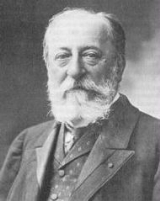
Camille Saint-Saëns
Overview
Charles-Camille Saint-Saëns (ʃaʁl kamij sɛ̃sɑ̃s) (9 October 183516 December 1921) was a French Late-Romantic composer, organist
, conductor, and pianist. He is known especially for The Carnival of the Animals
, Danse macabre
, Samson and Delilah
, Piano Concerto No. 2
, Cello Concerto No. 1
, Havanaise
, Introduction and Rondo Capriccioso, and his Symphony No. 3 (Organ Symphony)
.
Saint-Saëns was born in Paris, France on 9 October 1835. His father, a government clerk, died three months after his birth.
Organist
An organist is a musician who plays any type of organ. An organist may play solo organ works, play with an ensemble or orchestra, or accompany one or more singers or instrumental soloists...
, conductor, and pianist. He is known especially for The Carnival of the Animals
The Carnival of the Animals
Le carnaval des animaux is a musical suite of fourteen movements by the French Romantic composer Camille Saint-Saëns. The orchestral work has a duration between 22 and 30 minutes.-History:...
, Danse macabre
Danse Macabre (Saint-Saëns)
Danse macabre, Op. 40, is a tone poem for orchestra, written in 1874 by French composer Camille Saint-Saëns. It started out in 1872 as an art song for voice and piano with a French text by the poet Henri Cazalis, which is based in an old French superstition...
, Samson and Delilah
Samson and Delilah (opera)
Samson and Delilah , Op. 47, is a grand opera in three acts and four scenes by Camille Saint-Saëns to a French libretto by Ferdinand Lemaire...
, Piano Concerto No. 2
Piano Concerto No. 2 (Saint-Saëns)
The Piano Concerto No. 2 in G minor, Op. 22 by Camille Saint-Saëns, was composed in 1868 and is probably Saint-Saëns' most popular piano concerto. It was dedicated to Madame A. de Villers née de Haber. At the première, the composer was the soloist and Anton Rubinstein conducted the orchestra...
, Cello Concerto No. 1
Cello Concerto No. 1 (Saint-Saëns)
Camille Saint-Saëns composed his Cello Concerto No. 1 in A minor, Op. 33 in 1872, when the composer was age 37. He wrote this work for the Belgian cellist, viola de gamba player and instrument maker Auguste Tolbecque. Tolbecque was part of a distinguished family of musicians closely associated...
, Havanaise
Havanaise (Saint-Saëns)
The Havanaise in E major , Op. 83, is a composition for violin and orchestra based on the habanera rhythm, written in 1887 by Camille Saint-Saëns. It is one of the standards of the classical concertante repertoire....
, Introduction and Rondo Capriccioso, and his Symphony No. 3 (Organ Symphony)
Symphony No. 3 (Saint-Saëns)
The Symphony No. 3 in C minor, Op. 78, was completed by Camille Saint-Saëns in 1886 at what was probably the artistic zenith of his career. It is also popularly known as the "Organ Symphony", even though it is not a true symphony for organ, but simply an orchestral symphony where two sections out...
.
Saint-Saëns was born in Paris, France on 9 October 1835. His father, a government clerk, died three months after his birth.

